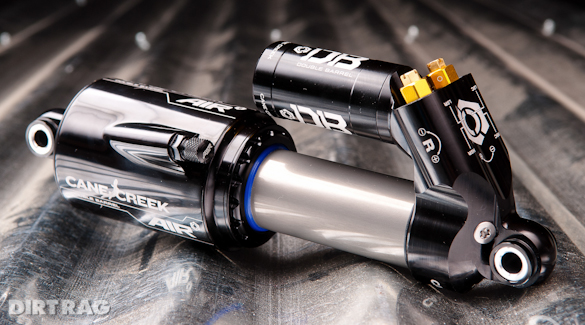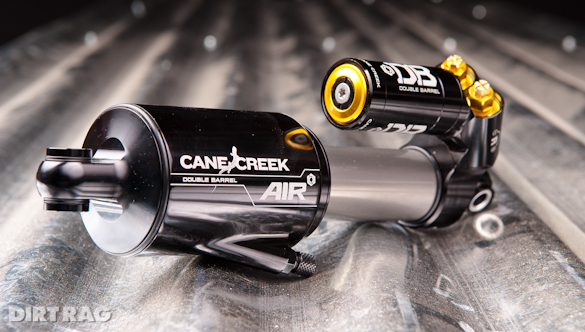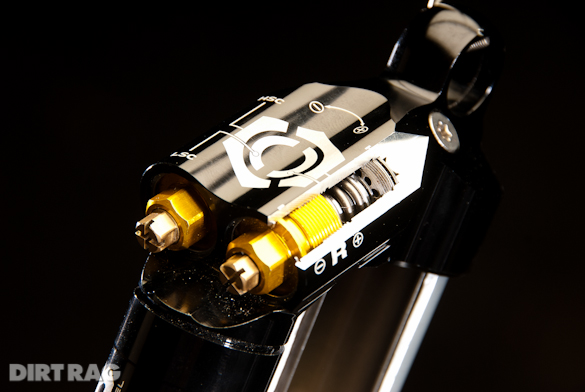Review: Cane Creek Double Barrel Air
Originally posted on February 12, 2014 at 13:26 pm
For gravity riders and racers, Cane Creek’s Double Barrel coil shock has long been the be-all-end-all, the place you arrive at when you’ve reached enlightenment. This sentiment explains why there’s been so much buzz surrounding the Double Barrel Air, which utilizes the same Twin Tube damper technology licensed from Öhlins.

On the Drawing Board
The Twin Tube damper is exactly that, two tubes, one nested within the other, which allow oil to flow back and forth between the compression and rebound chambers continuously. Upon compression, oil is displaced through the compression circuit, then out through a check valve in the rebound circuit. Upon rebound, this process is reversed. Each circuit, compression and rebound, offers independently adjustable high- and low-speed shim stacks.
All told, you’re offered six separate adjustments: air pressure, low-speed compression (LSC), high-speed compression (HSC), low-speed rebound (LSR), high-speed rebound (HSR), and air volume, via internal spacers.
With all of those adjustments, it’s easy to imagine being overwhelmed by initial set-up. Cane Creek offers a “Base Tunes” application on their website, but as of press time, only 14 bikes were listed. Recently, Cane Creek announced “The Lounge,” a forum where DB owners can share settings to help educate one another.
A call to Cane Creek revealed their baseline recommendation for bikes currently not listed in the Base Tunes app: begin tuning from the factory settings, which are square in the middle of the adjustment range. I found this solution to be problematic, as the Base Tunes recommendations are all over the map, based on suspension design.
Since I was initially testing the DB Air on a dw-link bike, my Pivot Firebird, I utilized the Base Tunes settings for the only dw-link bike listed, Ibis’ Mojo HD. As Cane Creek increases the number of bikes listed in their Base Tunes application, this initial set-up process should improve.
Let’s back up just a second to talk about frame compatibility. The DB Air is a large shock with the air can opposite the reservoir, unlike RockShox’s Monarch Plus or Fox’s DHX Air. This packaging complicates compatibility with some bikes, such as my Firebird. I had to procure a special linkage from Pivot that would accommodate the huge air can. However, the DB Air fit just fine on the Yeti SB-66 (reviewed in issue #166) used to finish the test. Consult your bike’s manufacturer and Cane Creek for fit questions.

On the Trail
The early-production shock I received displayed an inability to achieve full travel on either bike, even on the harshest of impacts. According to Cane Creek, there was an obstruction of the air passageway between the inner and outer air chambers due to variance in manufacturing tolerances. On harsh hits, this blockage caused an air pressure spike in some early shocks, such as mine. Cane Creek has since increased the size of the inner air chamber to resolve this issue. Owners of early DB Air shocks experiencing difficulty achieving full travel should contact Cane Creek.
Fortunately, with the updated shock installed on the SB-66, I was able to achieve full travel in appropriate situations when running proper sag. With the shock set-up as I preferred (the Firebird and the SB-66 required similar tuning), I found the DB Air to be extremely capable. Given the damper’s gravity roots, it’s no surprise the shock offers a big-hit vibe, handling hard hits with a composed, linear, well-damped response that’s usually characteristic of a coil shock.
On my SB-66 test bike, I found the DB Air allowed a bit more pedal-bob than the stock Fox RP23. Apparently, the stock RP23’s Boost Valve was better able to damp pedaling feedback. I found that if I cranked the LSC to minimize bob, I also dialed out a bit of the liveliness that I enjoyed in the SB-66. So, I settled for a compromise between pedaling performance and liveliness. Though surprising at first, this behavior makes sense: the DB Air is designed to maximize bump performance, not efficiency. Given the 150mm-plus travel, aggressive trail/all mountain/enduro market for which the DB Air is designed, this will be an acceptable trade-off for riders more concerned with consistent big-hit performance than outright pedaling efficiency.
The DB Air, like its coil brother, retails for $650, which is roughly $150 more than the DHX Air or RockShox Monarch Plus. Is it worth the upgrade? The answer depends primarily on your disposition. If you’re a tuner at heart, the DB Air will reward you with exactly the ride characteristics you desire—so long as you’re patient enough to get there. Suspension bracketing, anyone? To truly maximize your DB Air experience, you’ll have to approach set-up in a diligent and scientific manner—take notes, do experiments, etc. If that idea makes you cringe, this shock might not be for you. Oh, and you’ll have to be organized enough to not misplace the included wrench for the aforementioned adjustments.

Final Thoughts
In short, the main appeal to the DB Air is the ability to custom tune the ride characteristics you desire. RockShox’s Monarch, Fox’s DHX and Cane Creek’s DB Air all cater to the same crowd: those looking for burly descending performance without the weight of a coil spring. The difference? One is tuned by you, while the other two are tuned by suspension experts. I’d advise treading into this territory only if you’re confident in your suspension expertise. Made in the USA.
